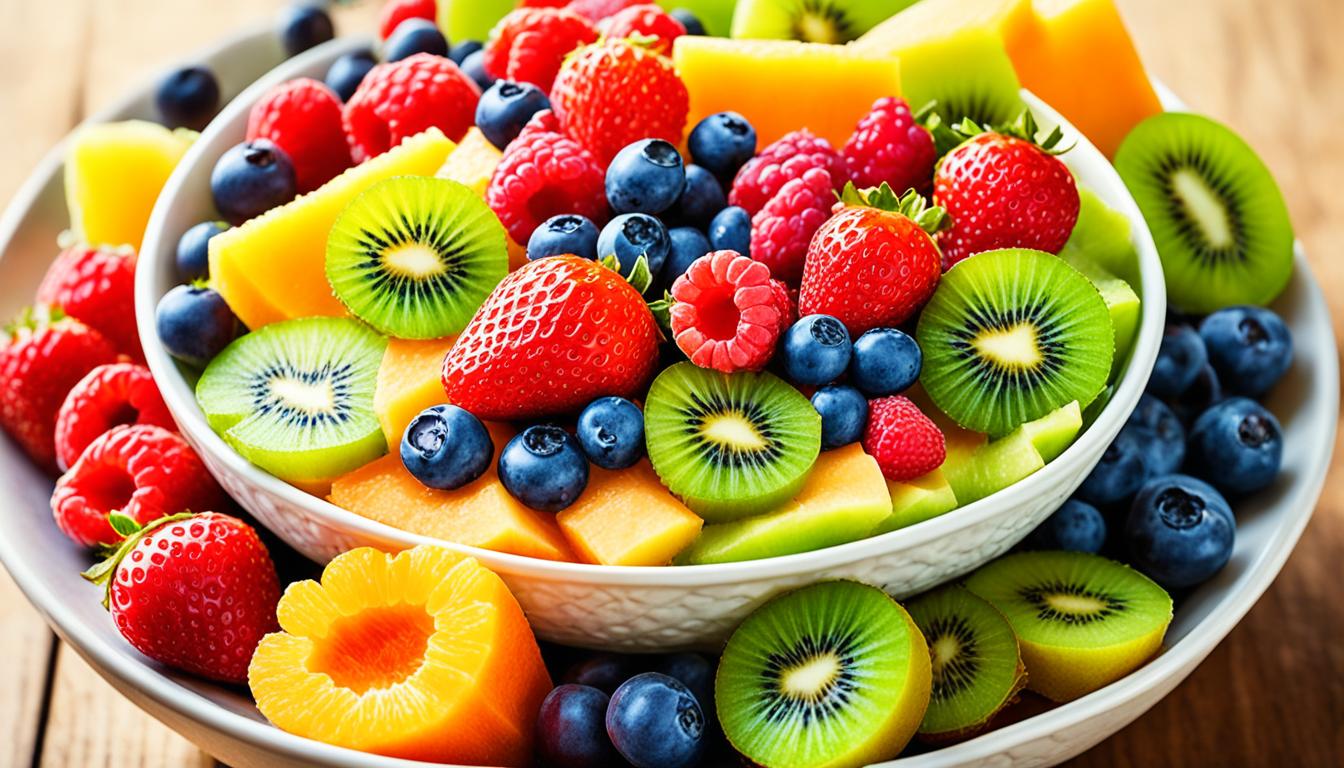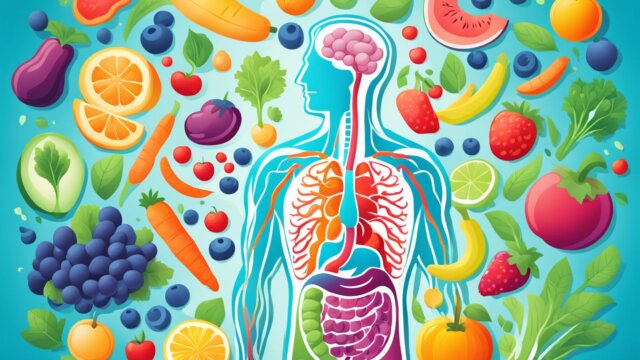FTC disclaimer: This post may contains affiliate links and we will be compensated if you click on a link and make a purchase.
Did you know that fructose makes up 10% of the average American’s diet? But, eating too much fructose can lead to obesity and metabolic problems. To stay healthy, try low-fructose fruits. They’re tasty and good for you, without the health risks.
Key Takeaways
- Fructose, a natural sugar in fruits, can have negative impacts on health if consumed in excess.
- Low-fructose fruits offer a sweet and nutritious alternative to higher-sugar options.
- Incorporating a variety of low-fructose fruits into your diet can support gut health and weight management.
- Citrus fruits, berries, and avocados are examples of low-fructose fruits to include in your meals and snacks.
- Balancing a low-fructose diet with essential nutrients, fiber, and lean protein is key for overall well-being.
Understanding the Dangers of Fructose
Fructose is a sugar found in fruits, veggies, and some foods. It gives energy and lowers blood sugar. But eating too much can lead to obesity and other health problems.
Some people can’t digest fructose well, causing stomach issues like diarrhea and bloating. A rare condition, hereditary fructose intolerance, can cause serious health problems if not treated.
What are the Risks of High Fructose Intake?
Eating too much fructose can make you more likely to be overweight and have metabolic syndrome. A study in 2016 found that teens who drank a lot of fructose had insulin resistance. Mice studies also show that high fructose can make tumors grow faster.
Fructose Malabsorption and Hereditary Fructose Intolerance
Fructose malabsorption means the gut can’t break down fructose, causing stomach problems. Hereditary fructose intolerance is rare but can lead to serious health issues if not treated. A diet low in fructose is key for those affected.
“Consuming too much fructose can promote intestinal tumor growth in mice,” according to a 2021 study.
The guidelines suggest limiting drinks with high fructose corn syrup to 4-8 oz with a meal. They also recommend eating small portions of foods with HFCS with a meal, not as a snack. They point out that two apples or four tablespoons of honey have as much fructose as one can of soda.
Eating less fructose is crucial for those with fructose issues. Knowing the dangers of too much fructose can help you make better food choices for your health.
Formulating a Low-Fructose Diet
Making a low-fructose diet is a smart way to handle health issues like fructose intolerance and digestive problems. It means knowing which foods have a lot of fructose and avoiding them. You also need to eat more low-fructose fruits and veggies and add low-FODMAP foods for gut health.
Step 1: Identify High-Fructose Foods to Avoid
Start by learning which foods have a lot of fructose and should be eaten less or not at all. Foods like apples, pears, and mangoes are high in fructose. Also, onions, garlic, and artichokes should be eaten in small amounts. Stay away from sweeteners like high-fructose corn syrup, honey, and crystalline fructose.
Step 2: Stock Your Kitchen with Low-Fructose Fruits and Veggies
Fill your kitchen with low-fructose fruits and veggies to balance out the high-fructose foods. Good choices include avocados, berries, citrus fruits, and veggies like leafy greens, asparagus, cauliflower, and mushrooms. Eating fresh or frozen fruits is better than canned ones.
Step 3: Incorporate Low-FODMAP Foods
Adding low-FODMAP foods helps with gut health and digestive issues. Be careful with ingredients like sorbitol, a sugar alcohol that can cause problems similar to fructose intolerance.
By following these steps, you can create a low-fructose diet. This diet can help with your health issues and make eating more balanced and healthy. Remember, the amount of fructose you can handle may differ. So, be patient and work with your doctor to find the best diet for you.
Low-Fructose Fruits
Managing a low-fructose diet means knowing which fruits are low in sugar. Many fruits are high in fructose, but there are tasty alternatives. These fruits can satisfy your sweet tooth without raising your blood sugar.
Avocados: The Fructose-Free Superfruit
Avocados are a great choice for a low-fructose diet. They have almost no fructose. These fruits are full of healthy fats, fiber, and important vitamins and minerals. Adding avocados to your meals and snacks helps support a low-fructose lifestyle.
Berries Galore: Blackberries, Raspberries, and More
Berries are a great low-fructose choice. Fruits like blackberries, raspberries, and strawberries are full of antioxidants and fiber. You can eat them fresh, blend them into smoothies, or use them as a topping for desserts.
Citrus Delights: Lemons, Limes, and Oranges
Citrus fruits like lemons, limes, and oranges have less fructose. These tangy and refreshing fruits can be added to water, sauces, or baked goods for flavor without too much fructose.
Adding these low-fructose fruits to your diet lets you enjoy their sweetness and nutrition. A balanced diet with low-fructose foods helps your gut health and manages conditions like fructose malabsorption or hereditary fructose intolerance.
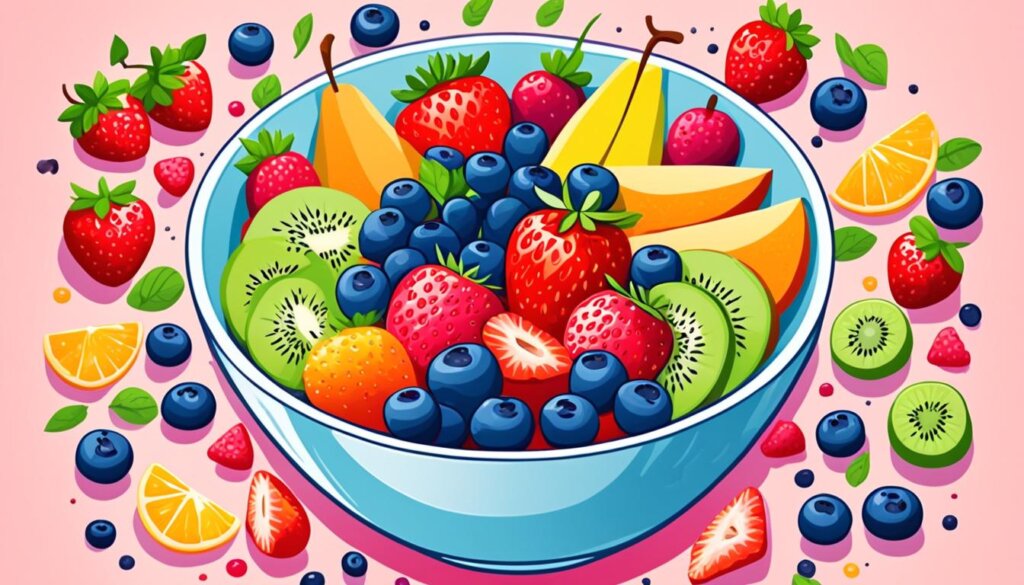
Balancing Nutrition on a Low-Fructose Diet
Following a low-fructose diet means you need to get all the nutrients your body needs. Eat a mix of low-fructose foods like fruits, veggies, whole grains, and lean proteins. These foods give you important vitamins, minerals, and antioxidants. Switching to fructose-poor products, like those by Frusano, can greatly cut down on fructose.
Variety: The Spice of a Healthy Diet
A balanced low-fructose diet means eating many different foods. Choose low-fructose fruits like avocados, berries, and citrus. Also, eat non-starchy veggies, whole grains, and lean proteins. This way, you get all the nutrients you need, and your meals will be tasty and fulfilling.
Fiber: Your Gut’s Best Friend
Fiber is key to a low-fructose diet because it helps with digestion and keeps you full. Good fiber sources are leafy greens, non-starchy veggies, and whole grains. Eating less sugar and fructose can lower the risk of kidney and urinary stones.
Protein Power: Lean Options for Low-Fructose Diets
Lean proteins like poultry, fish, and plant-based foods are good for a low-fructose diet. People who can’t handle fructose well often avoid these foods at first. But, they should try to eat a balanced low-fructose diet later.
Eating a variety of low-fructose foods helps your body get the nutrients it needs and keeps fructose levels in check. This way of eating can improve digestion and overall health.

Low-Fructose Fruit Alternatives
Berries and citrus fruits are great for those watching their sugar intake. But there are more tasty options like melons and stone fruits. These can be part of a diet low in fructose.
Melons: Honeydew and Cantaloupe Cravings
Melons like honeydew and cantaloupe are good choices. They are low in fructose and refreshing. Honeydew melons have 8g of sugar per 100g. Cantaloupes also have 8g of sugar per 100g and are full of beta-carotene. This helps keep your heart healthy and hydrated.
Stone Fruits: Peaches, Nectarines, and More
Stone fruits like peaches, nectarines, and plums are great for a low-fructose diet. Peaches have 13g of sugar per 100g and are packed with antioxidants and fiber. Apricots have only 9g of sugar per 100g and are full of vitamin A, antioxidants, and potassium. Remember to watch how much you eat and be aware of any sensitivities you may have.
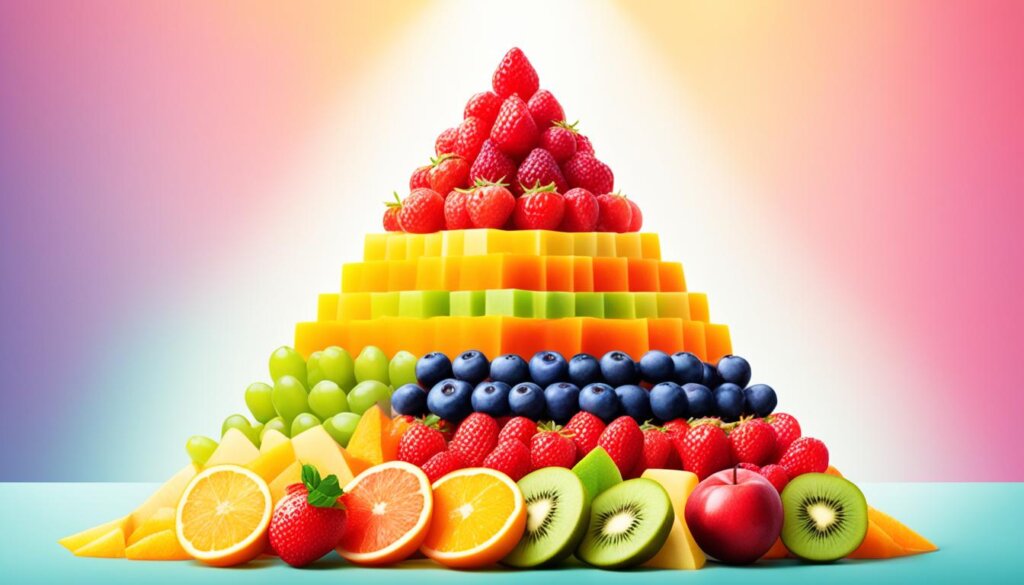
“Incorporating a variety of low-fructose fruits into your diet can help satisfy your sweet cravings while supporting overall health and well-being.”
Low-Fructose Fruits: The Key to Gut Health
Eating low-fructose fruits can greatly improve your gut health. Fructose, a major component of table sugar, can be hard for some to digest, causing stomach discomfort and health problems. By eating less of these high-fructose foods, you help your gut stay healthy, which can ease symptoms of irritable bowel syndrome (IBS) and fructose malabsorption.
Studies show eating lots of low-fructose fruits and veggies is good for your gut. Too much fructose can lead to health issues, like harming the liver and causing inflammation. High-fructose diets also make gut problems worse like colitis.
Low-fructose fruits like oranges and berries are great for your gut. They don’t cause as much gas or bloating. They’re also full of fiber, which helps with regular bowel movements and softens stool.
Adding fermented foods like kefir and sauerkraut can also help your gut. These foods are full of probiotics. They help with digestion and can ease constipation, diarrhea, and bloating.
Choosing low-fructose fruits and gut-friendly foods can really help your gut health.,,
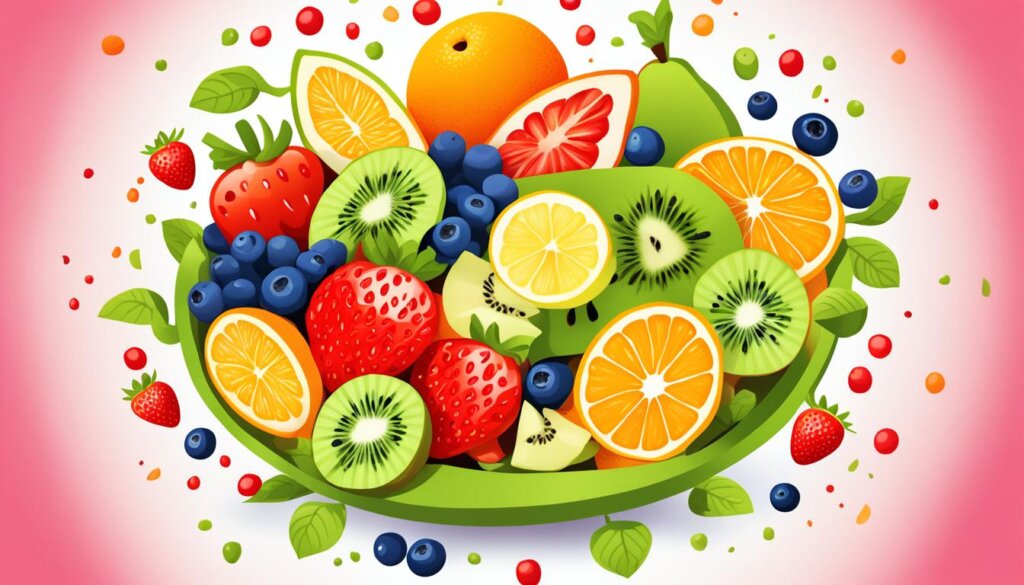
Adopting a low-fructose diet can be a key strategy for supporting a healthy gut and promoting overall well-being.
Low-Fructose Snacks and Desserts
Following a low-fructose diet doesn’t mean you have to skip tasty snacks and treats. You can still enjoy yummy smoothies, shakes, and baked goods by picking low-fructose fruits and ingredients. This way, you can satisfy your cravings and stick to your diet.
Fruity Smoothies and Shakes
Smoothies and shakes let you enjoy the sweet taste of low-fructose fruits. Choose berries like blackberries, raspberries, and blueberries for their low fructose and nutrients. Add citrus fruits like lemons, limes, and oranges for a refreshing touch. But avoid high-fructose fruits like apples, pears, and dried fruits to keep your diet on track.
Baked Delights with Low-Fructose Fruits
You can still enjoy sweet treats with low-fructose fruits in baked goods. Use apples, pears, or stone fruits like peaches and nectarines in your recipes. But watch out for added sugars or high-fructose ingredients that could ruin your diet. Try gluten-free and low-FODMAP baking mixes from Frusano, sweetened with maltose and dextrose, for a fructose-friendly option.
For a healthier choice, bake your own treats to better control the ingredients. With creativity, you can satisfy your sweet cravings with low-fructose delights.
Low-Fructose Snacks | Fructose Content |
|---|---|
Berries (blackberries, raspberries, blueberries) | Low |
Citrus fruits (lemons, limes, oranges) | Low |
Apples, pears, stone fruits (peaches, nectarines) | Moderate |
Frusano Spelt Butter Cookies, Chocolate Spelt Sandwich Cookies, Gluten-Free Blonde Chocolate Sandwich Cookies, Dark Chocolate Rice Cakes | Low |
Frusano Chai-Latte Protein Bars, Dark Chocolate Granola Bars | Low |
By using low-fructose fruits and trying new baking options, you can enjoy tasty snacks and desserts that fit your diet.
Fructose-Free Fruits for Diabetics
If you have diabetes, it’s important to watch your sugar intake. Luckily, many low-fructose fruits are good for you. These fruits are packed with nutrients and help keep your blood sugar stable.
Avocados are a great choice, with just 1g of sugar per fruit. Berries like blackberries, raspberries, and strawberries are also good, with 5-7g of sugar per cup. Citrus fruits like lemons, limes, and grapefruits are low in fructose, too. They can make your meals more refreshing.
Melons like honeydew and cantaloupe have less than 13g of sugar per cup. Peaches and nectarines are also good choices, with under 13g of sugar per medium fruit.
Fruit | Sugar Content |
|---|---|
Lemons | 2.1g per fruit |
Raspberries | 5.4g per cup |
Strawberries | 7g per cup |
Blackberries | 7g per cup |
Kiwi | 6.7g per fruit |
Grapefruit | 10.6g per half fruit |
Avocado | 1g per fruit |
Watermelon | Less than 10g per cup |
Cantaloupe | Less than 13g per cup |
Orange | 14g per fruit |
Peach | Less than 13g per medium peach |
For diabetes-friendly fruits, choose low-fructose options that are high in fiber and nutrients. Adding these fruits to your diet can help keep your blood sugar levels healthy and support your health.
A balanced diet with low-fructose fruits, veggies, and other nutrient-rich foods is key for managing diabetes. By choosing wisely, you can enjoy tasty fruits while controlling your blood sugar.
Conclusion
Eating more low-fructose fruits is good for your health and can help with digestion. It also helps with sweet cravings. Fructose is eaten a lot in Western. Eating too much high fructose corn syrup and fructose has led to more obesity and metabolic problems.
By picking fruits like avocados, berries, and citrus, you can enjoy fruit without the bad effects of too much fructose. Studies show eating whole fruits and veggies helps protect against diabetes and heart problems. Eating up to three fruits a day can lower the risk of type 2 diabetes.
It’s key to eat a balanced diet with lots of different foods. This way, you get all the nutrients you need. With some planning, you can enjoy low-fructose fruits and stay healthy.
Adding more low-fructose fruits to your meals helps with digestion and metabolism. The goal is to find the right mix that suits you. This makes eating fun and healthy.
FAQ
What are low-fructose fruits?
Low-fructose fruits include avocados, berries, citrus fruits, melons, and stone fruits like peaches and nectarines. These fruits are good for you and don’t raise blood sugar much because they have less fructose.
Why is it important to limit high-fructose foods?
Eating too much fructose can lead to health problems like obesity, insulin resistance, high triglycerides, and high blood pressure. It can also cause stomach issues in some people.
How do I create a low-fructose diet?
To eat less fructose, cut down on foods like apples, pears, and mangoes. Instead, eat more avocados, berries, and citrus fruits. Adding low-FODMAP foods helps your gut too.
What are the benefits of eating low-fructose fruits?
Low-fructose fruits provide important nutrients, fiber, and antioxidants without raising blood sugar. They also help your gut and can ease digestive problems.
Can I still enjoy sweet treats on a low-fructose diet?
Yes, you can still have sweet foods with low-fructose fruits, such as smoothies, shakes, and baked goods. Just watch out for added sugars or other foods high in fructose.
Are low-fructose fruits suitable for individuals with diabetes?
Yes, fruits like avocados, berries, citrus, and melons are great for people with diabetes. They offer important nutrients without greatly affecting blood sugar levels.
